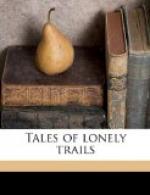Next day we rode from Natural Bridge to Payson in four and a half hours. Payson appeared to be an old hamlet, retaining many frontier characteristics such as old board and stone houses with high fronts, hitching posts and pumps on sidewalks, and one street so wide that it resembled a Mexican plaza. Payson contained two stores, where I hoped to buy a rifle, and hoped in vain. I had not recovered my lost gun, and when night came my prospects of anything to hunt with appeared extremely slim. But we had visitors, and one of them was a stalwart, dark-skinned rider named Copple, who introduced himself by saying he would have come a good way to meet the writer of certain books he had profited by. When he learned of the loss of my rifle and that I could not purchase one anywhere he pressed upon me his own. I refused with thanks, but he would not take no. The upshot of it was that he lent me his .30 Government Winchester, and gave me several boxes of ammunition. Also he presented me with a cowhide lasso. Whereupon Romer-boy took a shine to Copple at once. “Say, you look like an Indian,” he declared. With a laugh Copple replied: “I am part Indian, sonny.” Manifestly that settled his status with Romer, for he piped up: “So’s Dad part Indian. You’d better come huntin’ with us.”
We had for next day to look forward to the longest and hardest ride of the journey in, and in order to make it and reach a good camping site I got up at three o’clock in the morning to rout everybody out. It was pitch dark until we kindled fires. Then everybody rustled to such purpose that we were ready to start before dawn, and had to wait a little for light enough to see where we were going. This procedure tickled Romer immensely. I believed he imagined he was in a pioneer caravan. The gray breaking of dawn, the coming of brighter light, the rose and silver of the rising sun, and the riding in its face, with the air so tangy and nipping, were circumstances that inspired me as the adventurous start pleased Romer. The brush and cactus-lined road was rough, up hill and down, with ever increasing indications that it was seldom used. From the tops of high points I could see black foothills, round, cone-shaped, flat-topped, all leading the gaze toward the great yellow and red wall of the mesa, with its fringed borderline, wild and beckoning.
We walked our horses, trotted, loped, and repeated the order, over and over, hour by hour, mile after mile, under a sun that burned our faces and through choking dust. The washes and stream-beds were bleached and dry; the brush was sear and yellow and dust laden; the mescal stalks seemed withered by hot blasts. Only the manzanita looked fresh. That smooth red-branched and glistening green-leafed plant of the desert apparently flourished without rain. On all sides the evidences of extreme drought proved the year to be the dreaded anno seco of the Mexicans.




